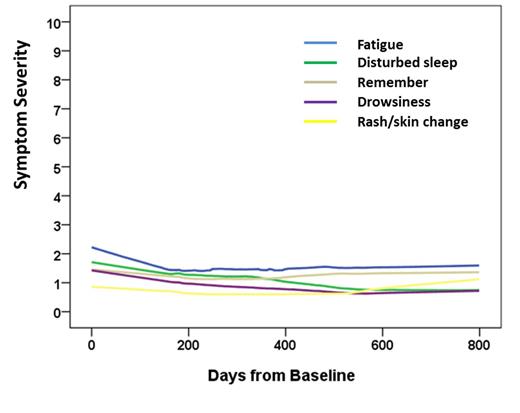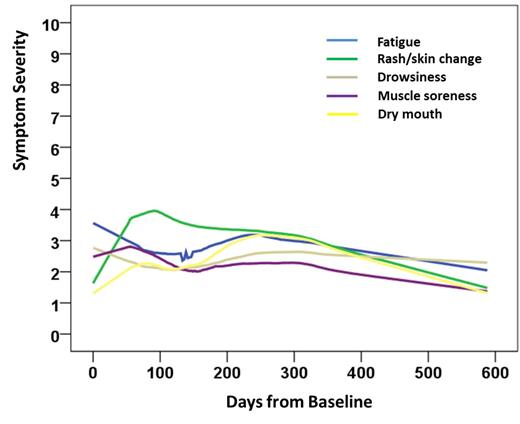Abstract

Retrospective analysis to correlate Impact of Symptom Burden and Quality of life to treatment outcome with Tyrosine kinase inhibitors in chronic myeloid Leukemia chronic phase
Binsah George, Lori Williams, Quiling Shi, Talha Badar, Susan O'Brien, Elias Jabbour, Guillermo Garcia-Manero, Nitin Jain, Farhad Ravandi, Gautam Borthakur, William Wierda, Charles Cleeland, Hagop Kantarjian and Jorge Cortes
Department of Leukemia, MD Anderson Cancer Center, Houston, Texas; Department of Symptom Research, MD Anderson Cancer Center
Background: With the advent of Tyrosine kinase inhibitors (TKI) in the treatment of Chronic Myeloid Leukemia chronic phase (CML-CP), patients (pts) live longer emphasizing the importance of symptom burden control to improve quality of life for these patients.
The objectiveof this study isto analyze the symptom burden with different TKIs used as initial therapy for CML-CP and their impact on outcome
Methods: We analyzed a total of 200 patients with CP-CML enrolled in prospective clinical trials with frontline TKI therapy; ponatinib [PONA]=33, dasatinib [DASA]=85, nilotinib [NILO]=82 between the years of 2005-2013. At time points including baseline, 3months, 6 months, 12months, 18months, 24 months pts symptom burden was assessed by the MD Andersron Symptom Inventory for CML (MDASI-CML) (Blood 2013; 122: 641).
Results: The overall median age was 48 years (range, 22-76) and the median follow up was 24 months (range, 11-31months). The entire cohort of 200 patients reached a complete cytogenetic response (CCyR) at 3 months, all with reverse-transcriptase (RT)-polymerase chain reaction (PCR) for the BCR-ABL fusion transcript of <10 percent (%) by international Scale (IS). At 6 months 184/200 pts (92%), 12 months 160/189 (84%), 18 months 129/181 (71%), and 24 months 125/173 (72%) had reached PCR BCR-ABL of <1%, <0.1%, <0.01%, and <0.0035%, respectively.
The mean worst symptom over 24 months of treatment with NILO and DASA was fatigue while for ponatinib was skin rash. The mean top 5 worst symptoms for DASA were (figure 1) fatigue (p=0.001 compared to baseline), drowsiness, memory loss, skin rash and sleep disturbance; for NILO (figure 2) top 5 were fatigue, sleep disturbance, memory loss, drowsiness, and skin rash; for patients treated with PONA (figure 3) top 5 symptoms were skin rash, fatigue, drowsiness, generalized muscle soreness, dry mouth. Mean overall symptom scores were 1.45 for DASA, 1.63 for NILO and 2.83 for PONA.
Work was the aspect of daily life most interfered with by symptoms for the whole cohort at baseline and over the 24 month treatment period (mean DASA=1.11, NILO=1.95 and PONA=2.43). By individual TKI, the top mean aspects of daily life (after work) interfered with in order of severity were, for PONA, activities (2.12), mood (2.11) and ability to enjoy life (2.09); for DASA, ability to enjoy life (1.07), activities (0.99) and mood (0.98); and for NILO, mood (1.05), ability to enjoy life (0.99), and activities (0.93). The mean overall impact of function scores were 1.74 for DAS, 1.29 for NILO and 2.18 for PONA.
In the DASA and NILO cohort who completed the MDASI-CML at 24 months, 6 of 19 (31%) did not reach MR4.5 (%BCR-ABL <0.0032%) while 13 (68%) achieved this response at 24 months (PONA cohort not included as most patients had not reached a 24 month treatment follow up at the time of this report). The top 5 significant symptom mean scores in the cohort who did not reach MR4.5 were fatigue (1.67), pain (1.33), memory loss (1.33), and drowsiness (1.17) and swelling of hands and legs (1.17) while for patients who reached MR4.5, fatigue (2.38), drowsiness (1.62), swelling of hands and legs (1.46), memory loss (1.46), and generalized pain (1.33) were the top mean symptoms. Patients that reached MR4.5 in this cohort had a higher mean symptom burden (1.65) in comparison to those not reaching MR4.5 (1.33)
Conclusions: Symptom burden is affected in different ways by different TKI used as initial therapy for CML. The NILO and DASA cohort that had MR4.5 at 24 months had a worse symptomatology mean in comparison to the cohort that did not reach MR4.5.
Cortes:Ariad, BMS, Novartis, Pfizer, Teva: Consultancy, Research Funding.
Author notes
Asterisk with author names denotes non-ASH members.

This icon denotes a clinically relevant abstract




This feature is available to Subscribers Only
Sign In or Create an Account Close Modal